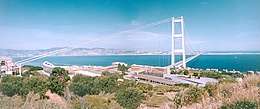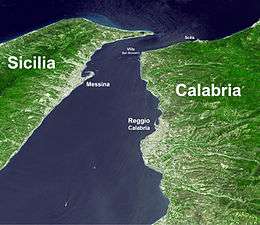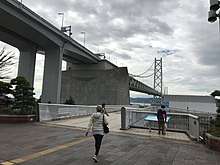Strait of Messina Bridge
The Strait of Messina Bridge is a long-planned suspension bridge across the Strait of Messina, a narrow section of water between the eastern tip of Sicily and the southern tip of mainland Italy, specifically between north Messina's Torre Faro[1][2] and Villa San Giovanni.[3]
Strait of Messina Bridge Ponte sullo stretto di Messina | |
|---|---|
 A rendering view from Calabrian coast. | |
| Coordinates | |
| Carries | Six lanes and two emergency lanes. Two rails and two railway sidewalks. |
| Crosses | Strait of Messina |
| Locale | Messina and Villa San Giovanni |
| Characteristics | |
| Design | Suspension bridge |
| Total length | 3,666 metres (12,028 ft) |
| Height | 382.6 metres (1,255 ft) (pylons) |
| Longest span | 3,300 metres (10,800 ft) |
| Clearance below | 76 metres (249 ft) |
| History | |
| Designer | Stretto di Messina |
| Construction start | 2009 (work on the Calabrian coast) |
| Construction end | - |
 Strait of Messina Bridge Location in Italy | |
While the bridge has been proposed since ancient times, a detailed plan was made in the 1990s for a suspension bridge. The project was cancelled in 2006, under Prime Minister Romano Prodi.[4] However, on 6 March 2009, as part of a massive new public works programme, Prime Minister Silvio Berlusconi's government announced that construction of the Messina Bridge would indeed go ahead, pledging €1.3 billion as a contribution to the bridge's total cost, estimated at €6.1 billion.[5] The project was cancelled again on 26 February 2013, by Prime Minister Mario Monti's government due to budget constraints.[6]
The bridge would have been the longest suspension bridge in the world, almost doubling the main span of the Akashi Kaikyō Bridge in Japan. The bridge would have been part of the Berlin–Palermo railway axis (Line 1) of the Trans-European Transport Networks (TEN-T).
Geography

The Strait of Messina is a funnel-shaped arm of sea that connects the Ionian Sea in the south to the Tyrrhenian Sea to the north. The width of the strait varies from a maximum of approximately 16 km (9.9 miles) (between Capo d'Alì in Sicily and Punta Pellaro in Calabria) to a minimum of approximately 3 km (1.9 miles) between Capo Peloro in Sicily and Torre Cavallo in Calabria.[7] A similar distance separates Pezzo and Ganzirri; at that point, the strait is only 72 m (236 ft) deep, while in other places it can reach 200 m (660 ft) deep. It is also characterised by strong currents.
History
The idea of a bridge crossing the strait is an old one. The Romans considered building a bridge joining Calabria and Sicily made of boats and barrels. Charlemagne considered joining the two sides with a series of bridges. This idea was revived by the Norman adventurer Robert Guiscard in the 11th century and by Roger II of Sicily in the 12th century. In 1876, Giuseppe Zanardelli was convinced that the strait could be linked by either a bridge or a tunnel. In 1866, public works minister Stefano Jacini gave Alfredo Cottrau, an internationally recognised engineer, the task of drawing up plans for a bridge between Calabria and Sicily. Later, in 1870, Navone proposed building a tunnel based on Napoleon's idea of a tunnel under the English Channel. This tunnel was to start at Contesse and was to pass below Messina and Ganzirri at a depth of 150 m, crossing the Strait to Punta Pezzo and resurfacing at Torre Cavallo.
A geologic study of the area of the Strait of Messina was published in 1909 (historical Arch. Sicilian year XXXIV f.1,2) and in 1921, a study of an undersea tunnel was released to the Geographic Conference of Florence. A group of railway civil engineers studied the possibility of a suspension bridge but nothing came of it. The idea was revived in 1953 by master bridge builder David B. Steinman with a plan to build a bridge that crossed the Strait using two 220 m (720 ft) towers sunk in 120 m (390 ft) deep waters. The proposed 1,524 m (5,000 ft) span would have represented a world record, eclipsing the then-longest 1,275 m (4,183 ft) centre span of the Golden Gate Bridge and beating the 2,256 m (7,402 ft) Mackinac Straits Bridge (then in planning) with a total length of 2,988 m (9,803 ft). The proposed structure would have cleared the sea by 50 m (160 ft) to allow shipping passage, and to have had two decks, the lower to carry two rail lines, and 7 m (23 ft) above, a road deck 30 m (98 ft) wide. The main cables would have been 1 m (39 in) in diameter. The bridge would have required 12,000 workers and cost hundreds of billions of lire.
- Early planning stages
- In the 1960s, a wide variety of proposals were advanced, including everything from submerged tubes to floating struts, pontoons and a revolving central section of the bridge. None turned out to be realistic.
- In 1969, an international design competition was arranged.
- In the 1970s, feasibility studies were undertaken by the State Railways leading to the creation of a private company with responsibility for planning the crossing of the Strait.
- In the 1980s, the Messina Strait Company (Stretto di Messina S.p.A.) was set up with support from the State Railways, the regions and IRI. It concluded that it would be feasible to build a suspension bridge.
- Detailed plans followed in the 1990s with final approval from the High Council of Public Works (Consiglio Superiore dei Lavori Pubblici).
Development of detailed plans

The 2006 plan called for a single-span suspension bridge with a central span of 3,300 m (10,800 ft). This would have made the span more than 60% longer than the Akashi-Kaikyo Bridge in Japan—the largest suspension bridge in the world at 1,991 m (6,532 ft).[8]
Plans called for four traffic lanes (two driving lanes and one emergency lane in each direction), two railway tracks and two pedestrian lanes. In order to provide a minimum vertical clearance for navigation of 65 m (213 ft), the height of the two towers was to be 382.6 m (1,255 ft). This would have been taller than the Millau Viaduct in France (currently the tallest bridge in the world at 341 m (1,119 ft)). The bridge's suspension system would have relied on two pairs of steel cables, each with a diameter of 1.24 m (49 in) and a total length, between the anchor blocks, of 5,300 m (17,400 ft).[9]
The design included 20.3 km (12.6 miles) of road links and 19.8 km (12.3 miles) of railway links to the bridge. On the mainland, the bridge was to connect to the new stretch of the Salerno-Reggio Calabria motorway (A3) and to the planned Naples-Reggio Calabria High-Speed railway line; on the Sicilian side, to the Messina-Catania (A18) and Messina-Palermo (A20) motorways as well as the new Messina railway station (to be built by Rete Ferroviaria Italiana).[10]
The bridge was planned to connect Reggio Calabria to Messina, the two cities that face each other on either side of the strait, in order to form a single city. This ambitious urban project was called Area Metropolitana integrata dello Stretto (Integrated Metropolitan Area of the Strait) or simply Città dello Stretto (City of the Strait). Among the controversies surrounding the building of the bridge was strong opposition to the formation of the new city by various Sicilian nationalist groups.[10]
On 12 October 2006, the Italian Parliament voted 272 to 232 in favour of abandoning the plan due to the bridge's "doubtful usefulness and viability", as well as the inability of the already burdened Italian treasury to bear its share of the cost. Additionally, transport minister Alessandro Bianchi pointed out that the road and rail links leading to the location of the proposed bridge are not capable of supporting enough traffic to make the bridge profitable. Other reasons for abandoning the plan were earthquake risk and fears that much of the funds would be diverted to the criminal organisations Cosa Nostra and 'Ndrangheta.[4][11]
Contracting parties
A construction consortium led by Impregilo was chosen in 2005, with actual construction set to begin in the second half of 2006. The bridge was designed by Danish architects at Dissing+Weitling in close collaboration with the Danish engineering firm COWI.[12]
On 27 March 2006, Impregilo and Stretto di Messina announced that they had signed a contract assigning final project planning to a General Contractor. Impregilo S.p.A., the lead partner had a 45% share. Other participants were Spain’s Sacyr (18.70%), the Italian companies Società Italiana per Condotte D’Acqua S.p.A. (15%) and Cooperativa Muratori & Cementisti-C.M.C. of Ravenna (13%), Japan’s IHI Corporation (6.30%), and Consorzio Stabile A.C.I. S.c.p.a (2%). The General Contractor would also be assisted by the Danish and Canadian companies COWI A/S, Sund & Baelt A/S and Buckland & Taylor Ltd., who would handle project engineering. Completion was projected to take six years, at a projected cost of €3.9 billion. The first task of the General Contractor was to draw up the final project.[13]

| Function | Companies | Role |
|---|---|---|
| General contractor |
Group leader (45%) | |
| Mandator | ||
| Mandator | ||
| Mandator | ||
| Mandator | ||
| Mandator | ||
| Mandator | ||
| Mandator | ||
| Mandator | ||
| Mandator | ||
| Project management | ||
| Environmental monitoring | Group leader | |
| Mandator | ||
| Mandator | ||
| Mandator | ||
| Mandator | ||
| Insurance broker |
Later initiatives

| Year | Initiative | Notes |
|---|---|---|
| 2008 | On 15 April, Silvio Berlusconi was re-elected prime minister of Italy and vowed to restart the project to build the bridge. The following month, Altero Matteoli, Italy's minister of infrastructure and transport confirmed the government's intent to restart work on the bridge in a letter to Pietro Ciucci, the president of Società Stretto di Messina. | [16][17] |
| 2009 | On 6 March, as part of a massive new public works programme, Silvio Berlusconi's government announced that plans to construct the Messina bridge had been revived, pledging €1.3 billion for the bridge as a contribution to its estimated cost of €6.1 billion. Some 3,300 m (10,800 ft) long and 60 m (200 ft) wide, the bridge would be supported by two 382 m (1,253 ft) pillars, each higher than the Empire State Building in New York. There would be two motorway lanes and one emergency lane in each direction, catering for 6,000 vehicles per hour, a double track railway for up to 200 trains a day, and two independent lanes for service traffic and pedestrians. Berlusconi claimed that work will be completed by 2016. Until 2006, when the project was halted, the work had been assigned to a consortium of Italy's Impregilo, Condotte d'Acqua, Cooperativa Muratori & Cementisti (CMC), and Consorzio Stabile A.C.I., alongside Spain's Sacyr, and Japan's Ishikawajima-Harima Heavy Industries. | [18][8][8] |
| On 23 December, preparatory work started with the diversion of the Tyrrhenian railway at Cannitello on the Italian mainland side of the strait. | [19] | |
| 2013 | In February, the project was shut down by Mario Monti, the new Italian Premier, by the government for lack of funds. | [20] |
| 2016 | The project was reconsidered by the government of Matteo Renzi. | [21] |
| 2019 | On 6 October, the Tribunale amministrativo regionale (TAR) postpones to 8 July 2020 the hearing for the decision on the dispute undertaken by Salini Impregilo against the Italian Government for the payment of the huge penalties for the failure to execute the Bridge as decided by the Monti Cabinet in 2013. | [22] |
| 2020 | On 3 June, just when Italy is trying to get out of the crisis due to COVID-19 pandemic, Premier Giuseppe Conte returned to talk about Messina Bridge, declaring that the Italian government would return to evaluate the resumption of work without prejudice. | [23][24] |
Criticisms
Supporters see the bridge as a huge job-creation scheme and a boost for tourism. However, opponents question the priority of the bridge, claiming that if the government concentrated instead on making Sicily's roads more efficient, drivers would be able to reach the coast more quickly at a fraction of the bridge's cost.[25]
Others believe that the bridge is quite unnecessary, since the local economy is already providing for the conversion of the local former NATO airport in Comiso into a commercial terminal to export vegetables to Northern Europe. Alternatively, a much cheaper revamping of the current structures is claimed to be sufficient (for instance, the ferry lines on the Calabria side are now accessible by trucks only by driving through very narrow streets, which are a tight bottleneck for transport). Another argument against the bridge is the poor state of the transport infrastructure in Sicily, particularly the railroad and the A20 autostrada linking Messina to Palermo, and the poor state of the A3 autostrada on the mainland linking Reggio Calabria to Naples.
The greatest structural design problem of the bridge itself is the aerodynamic stability of its deck under wind and seismic activity.[26] There are also concerns about the environmental impact of the bridge, its actual feasibility, and its resistance to earthquakes, common in this region.
See also
References
- "Plans For Record Bridge Stir Stormy Feelings, Torre Faro, Italy (22 August 2004)". dailypress.com. Retrieved 23 December 2016.
- "Satellite image of where the bridge will be constructed across the Straits of Messina". roadtraffic-technology.com. Retrieved 16 September 2016.
- "The Bridge over the Strait of Messina, Italy". ejatlas.org. Retrieved 16 September 2016.
- "Italy drops Sicily bridge plans". BBC News. 12 October 2006.
- "Italy revives Sicily bridge plan". BBC News. 6 March 2009. Retrieved 17 May 2011.
- Danilo Masoni; Michael Roddy (26 February 2013). "Sicily bridge project sinks in Italy budget mire". GlobalPost. Archived from the original on 5 March 2016. Retrieved 31 July 2017.
Italy's government dashed the latest dreams of building a bridge linking Sicily to the mainland on Tuesday [26 February 2013], scrapping the multi-billion-euro project because of tight budgets. The decision to block the controversial plan, strongly backed by right-wing leader and media magnate Silvio Berlusconi, comes one day after a general election produced no clear winner and set Italy on course for political paralysis.
- "Sicily (island, Italy) -- Britannica Online Encyclopedia". Encyclopædia Britannica. 17 February 2009. Retrieved 20 February 2011.
- Sicily to get longest bridge from TimesOnline. Retrieved 8 March 2009.
- Italy revives Messina Straits bridge from Construction Europe. Retrieved 9 March 2009.
- "Ponte sullo Stretto: un maxi-documento contro le "bugie pubblicate dalla stampa locale"" (in Italian). strettoweb.com. 17 December 2013. Retrieved 21 June 2020.
- Hooper, John (12 October 2006). "Italian MPs kill plan to bridge Sicily and mainland". London: Guardian. Retrieved 24 May 2010.
- "Bridges" (PDF). cowi.com. Retrieved 21 June 2020.
- Straits Bridge: Impregilo and Stretto di Messina close contract Archived 18 November 2008 at the Wayback Machine. Retrieved 10 March 2009.
- "Salini Impregilo cambia nome: da oggi nasce Webuild - la Repubblica". Repubblica.it. Retrieved 4 May 2020.
- "Ponte sullo Stretto, la storia infinita di un'opera da 5,2 miliardi" (in Italian). st.ilsole24ore.com. 27 September 2016. Retrieved 21 June 2020.
- Italy in shift to two-party politics | The Australian
- "Italian minister commits to Messina Bridge". Bridge Design and Engineering. 27 May 2008. Archived from the original on 6 July 2009. Retrieved 23 December 2008.
- Juhani Virola: The Messina Strait Bridge – Greatest Bridge Ever Built Archived 22 July 2011 at the Wayback Machine. Retrieved 10 March 2009.
- "Ponte stretto: al via i lavori (Straits bridge: Work begins)" (in Italian). ItaliaOnLine. 23 December 2009. Archived from the original on 18 May 2016. Retrieved 23 December 2009.
- "Sicily bridge project sinks in Italy budget mire". Global Post. 26 February 2013.
- The Independent,"Italian PM Matteo Renzi revives plan for bridge from mainland Italy to Sicily"
- "Ponte Messina: slitta a luglio 2020 l'udienza del Tar su contenzioso con Salini Impregilo" (in Italian). stradeeautostrade.it. 7 October 2019. Retrieved 22 October 2019.
- "Use crisis to redesign country - Conte". ansa.it. 3 June 2010. Retrieved 5 June 2020.
As for a revived proposal to build a bridge across the Messina Strait to Sicily, Conte said "I will evaluate everything without prejudice".
- "Conte: «On EU funds, comparison with everyone, it is not a treasure of the government»". archyde.com. 4 June 2010. Retrieved 18 June 2020.
And the Messina bridge? “I will also evaluate without prejudice the bridge over the Strait.” And the Mes? “When we have the regulations I will study them and with Parliament we will decide.”
- Annie Magnus: Italy's 'Bridge to Nowhere'. PostGlobal from Newsweek/Washington Post. Retrieved 8 March 2009.
- "Structurae, Messina Straits Bridge, see notes". structurae.net. Retrieved 16 September 2016.
Further reading
- Fabio Spadi (2001) "The Bridge on the Strait of Messina: 'Lowering' the Right of Innocent Passage?" International and Comparative Law Quarterly 50: 411 ff.
- "From Rome to Sicily: Plane or Train?" Expert Travel Advice, The New York Times, Feb. 7, 2008 The New York Times.
- Fabio Brancaleoni, Giorgio Diana, Ezio Faccioli, Giuseppe Fiammenghi, Ian Firth, Niels J. Gimsing, Michele Jamiolkowski, Peter Sluszka, Giovanni Solari, Gianluca Valensise, Enzo Vullo: Messina Strait Bridge - The Challenge and the Dream, Taylor and Francis, 2009, 300p, ISBN 978-0-415-46814-5
External links
- Bridge design site (English version) - Currently under maintenance
- (in Italian) Ponte di Messina - A complete and detailed private site
- Messina Bridge
- Strait of Messina with the Messina Bridge
- Bridging the Strait of Messina
- BBC News "Italy revives Sicily bridge plan"
- BBC News "Sicily bridge constructor named"
- Transcript of RAI broadcast Report about the bridge. (in Italian)